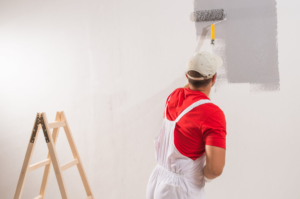Tacoma Bathroom Remodeling is a substantial investment of time and money that significantly affects one of the most used rooms in your home. It is important to understand the basics of a successful project before committing to one.

The first step is planning and design. It’s crucial to find a design theme that reflects your style.
Whether you’re building from the ground up or simply updating an existing bathroom, a well-thought-out layout is key to creating your dream bathroom. The first step is identifying your needs and determining how you’ll use the space. A well-considered plan will help you avoid costly mistakes and keep your project on budget.
Using an online design tool, like RoomSketcher, is the easiest way to visualize your bathroom remodel and create a floor plan. This will allow you to illustrate your vision to your contractor and ensure everyone’s on the same page. Using our point-and-click software, you can also easily create 2D floor plans and 3D designs that will help you compare your options and get the best result for your investment.
To make the most of your bathroom’s square footage, consider maximizing the number of usable wall spaces by creating a more open layout. This will provide plenty of space for a vanity, tub, shower, and storage. A smaller layout can still work well, however, if you’re looking for more of an elegant powder room that can double as a stylish home accent.
When it comes to laying out your bathroom, it’s important to remember that your doorway will take up some of the space. For this reason, you should place your sink and toilet so they don’t block the doorway, which is required for ADA compliance.
It’s also a good idea to think about who will be using your bathroom before you start planning. For example, if you have kids, you may want to include a tub and extra space for bath toys. On the other hand, if your bathroom is for just one person, a single sink might be enough.
Plumbing
If you’re tackling an extensive bathroom remodel, you might need to upgrade your plumbing and electrical systems. This is a vital part of the project that allows you to take advantage of new design features like heated floors or a rainfall showerhead. It also ensures that all your fixtures are working properly and efficiently.
A remodel can be as simple as a rip and replace or as complex as a full renovation. To avoid costly mistakes, it’s important to know your budget and understand the scope of the work. A good Sweeten contractor will help you establish a timeline and manage all subcontractors, so you can rest assured that the installation process is on track.
To start your remodel, shut off the water and remove any existing fixtures and flooring. This includes toilets, vanities, bathtubs and showers, cabinets, mirrors, and electrical outlets. This is a messy part of the process, but it makes room for demolition and exposes plumbing and electrical wiring for rough-in, a construction term for the initial phase of installing wiring and preparing the walls for fixtures.
This is where the big changes happen in your remodel, and this stage is when you can really see your vision for the space come to life. Installing the new layout and changing out fixtures is a delicate balance of craftsmanship and precision, making sure that everything fits correctly and functions seamlessly.
Depending on your renovation, you may need to obtain a permit for your project. Permit requirements differ by location and project scope, so it’s best to consult with an experienced Sweeten contractor to determine what your specific needs are. They’ll guide you through the process and make sure you have the necessary paperwork in order.
Electrical
Bathroom remodeling is one of the home improvement projects with the highest return on investment, enhancing both comfort and value. The addition of smart technology, from heated floors to voice-activated lighting, makes bathrooms the ideal place to unwind and relax while incorporating eco-friendly materials and appliances.
While some homeowners make cosmetic changes, such as repainting or installing new fixtures, true remodeling encompasses major changes to the layout and design of a space. It includes a thorough evaluation of how the space is used and what improvements can be made to increase functionality. Remodels are also a great opportunity to upgrade the electrical system, including adding outlets and upgrading light switches to energy-efficient LED bulbs.
Most notably, it’s important to consult with a licensed electrician early in the process. This ensures that the electrical system is upgraded in accordance with current safety standards and building codes. This can be especially important for older homes, as the wiring may not meet modern standards. For example, all outlets in areas that are exposed to water should be GFCI, or ground fault circuit interrupter, to reduce the risk of electric shock.
Depending on the scope of the work, you may need to obtain permits. Generally, a permit is required for structural changes, such as moving walls, and for plumbing and electrical upgrades, such as adding or changing outlets. For a permit application, it’s best to talk with a local inspector. He or she can provide specific guidelines and requirements tailored to your project. Additionally, your electrician can help you determine the appropriate level of insulation for electrical wiring and ensure that your circuits are up to code. This will prevent any accidental overloading of the system, which can lead to short circuits and fires.
Lighting
Adding new lighting and upgrading old fixtures can be a major part of any bathroom remodeling project. It’s important to hire a qualified electrician, however, as many fixture, switch, and bulb upgrades require either new wiring or adjustments to the existing breaker box.
The ideal bathroom lighting balances bright light for grooming with softer levels for an overall pleasant ambiance. Layering is key to this balance, and dimmers can be used to allow household members to quickly customize the lighting for their specific needs at any given moment.
In addition to recessed lights, consider placing some strip lighting under cabinets or along countertops to help illuminate hard-to-light areas. This can help keep the bathroom looking clean and fresh at all times, and it’s easy to add or remove if the homeowner wants to change the look of the space later on.
Finally, consider installing a heated floor in the shower or bath area. This will keep the floor nice and warm for stepping out of the shower or tub, as well as reduce the need to mop up water or ice that would otherwise form on the cold tile.
The bathroom is a place of personal hygiene and relaxation, but the lighting can make it feel dark and uninviting rather than bright and inviting. By working with a professional contractor, homeowners can be confident that the finished space will be exactly how they want it to function. And that’s a win-win for everyone involved!
Finishes
The finishes you choose can dramatically impact the aesthetics and functionality of your bathroom. From porcelain tiles to acrylic bathtubs, the options are endless. It’s important to consider your budget, maintenance preferences, and design goals when choosing your shower and bathtub finishes. The experts at Dreamstyle Remodeling are here to help you navigate this process and transform your bathroom into the space of your dreams.
To add a touch of warmth to your space, try using a brass accent in your vanity, showerhead, or fixtures. This finish is durable and can complement a variety of different styles, from traditional to farmhouse to modern. Another great option is oil-rubbed bronze, which has a rich, dark color with a hint of copper. It’s ideal for a classic, vintage-style bathroom and looks beautiful alongside natural wood accents.
It’s also a good idea to make sure your finishes match so that your bathroom feels cohesive and well-planned. For example, if you are going with a dark tile, try matching the trim and hardware to create a cohesive look. The same goes for lighting and countertops—make sure the colors and materials you select coordinate.
If you’re planning on selling your home in the future, it’s important to keep resale value in mind when making your design choices. Choose upgrades that will appeal to a broad range of buyers, such as energy-efficient lighting and modern storage solutions.
A full gut renovation will likely be the most expensive part of your project. However, it can increase your home’s resale value and give you the luxury of designing a space that perfectly suits your needs. Before diving into the renovation process, it’s important to set a clear budget and use tools like project calculators to help ensure you don’t overspend.
